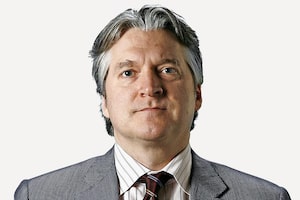My grandparents were married in Winnipeg on August 16, 1930. Not long after their nuptials, they packed their belongings into a Model T Ford and drove to Ottawa. They were in their twenties and the trip was replete with flat tires, engine trouble and missed directions. It turned out to be a good beginning. They were married 52 years.
Like the Model T they rode in, their journey was a product of its age, a time when youthful romance was epitomized by the automobile, specifically the long road trip; a sentiment articulated by F. Scott Fitzgerald 100 years ago this month in his 1924 essay, “The Cruise of the Rolling Junk,” which ran in three instalments in MOTOR: The National Motoring Magazine.
A road trip promised adventure and relief from the “disillusion of all the stationary world.” Fitzgerald’s had begun in 1920. One morning his new bride Zelda had craved peaches and biscuits, and so, after breakfast, the pair set off to drive from Connecticut to her hometown in Alabama in a 1918 Marmon (the Rolling Junk). To cruise the country by automobile was “To be young, to be bound for the far hills, to be going where happiness hung from a tree, a ring to be tilted for, a bright garland to be won.”
Not many people would express such idealism now. As Valentine’s Day approaches, it’s hard to find hope or optimism connected to the automobile. To travel by car is to be stuck in traffic, pondering the pointlessness of it all. There is, however, a little vigour left in the North American romance with the automobile. Tinder’s “Year in Swipe” reports that “car dates” are one of the most popular trends on TikTok.
According to Mashable, “You pick up your date in your car, drive somewhere remote with a nice view — or to a drive-through food place — and have your date in the parked car. The rest is like any other meetup: Getting to know each other, bonding, tensions rising, you know how it goes. And car dates work for cohabiting couples too; beat cabin fever and get some bonding time locked-in by taking your car to a park for dinner instead of sitting in the kitchen.”
Modern car dates do not resemble the erotic exploits of the late-twentieth century. I have written extensively about cars and carnal pursuits. Including a history of sex in cars, a treatise on why you should have sex in your car and a report on the effect of the pandemic on in-car dalliances. The element every article shares is that spontaneity is the foundation of passionate automobile interludes. If you’re an adult, you make out in your car because you are too passionate to make it home. If you’re a teenager or in your twenties, you make out in your car because you’re passionate and you can’t go home because your parents are there.
The car dates depicted on TikTok are the opposite of spontaneous. Great care and attention is paid preparing the vehicle, adding cushioning, pillows, snacks, cozy lights and blankets. The emphasis is on chivalric love not copulation. There is no hint of Jazz Age petting parties or paradise by the dashboard light of the 1970s. Mashable reports car date enthusiasts say they are “essential,” “unbeatable” and “the best kind of date.”
They could be onto something. Without revealing too much, I can confidently maintain that no one ever referred to an intimate vehicular encounter as “the best kind of date.” Cramped, poorly ventilated, the romance-killer that is bucket seats, car “dates” happen in less-than-ideal conditions. Aphrodite’s adrenaline makes up for these obstacles but does not negate them.
It may be that today’s genteel car dates are more about the anticipation than the act itself. If so, then they are in line with the conclusion that Scott and Zelda reached, after a road trip comprised of “speeding, bribery, toll-dodging and obtaining help under false pretenses.”
“The joys of motoring are more or less fictional,” Zelda assured a friend when they arrived back to their home in Westport, Conn.
In a 1974 essay, scholar Roderick S. Speer wrote that “although ‘The Cruise’ is light-hearted and breezy, we can see fermenting in it the serious themes of Gatsby” - which is full of automobile symbolism. He noted Fitzgerald deemed the trip a failure and would “not make such a trip again; all that remains of value seems to be the memory of the illusion which impelled him in the first place.”
Car dates, with their emphasis on courtship and conversation rather than quick carnal gratification, are not reviving the romance of the automobile, so much as honouring its restless illusion. This Valentine’s Day, as pillows are placed on backseats and snacks set in baskets, car daters will not celebrate the romance of the automobile but instead mark its passing.
“My affection goes with you, Rolling Junk,” wrote Fitzgerald in his essay’s conclusion. “With you and with all the faded trappings that have brightened my youth and glittered with hope or promise on the roads I have travelled – roads that stretch on still, less white, less glamourous, under the stars and the thunder and the recurrent inevitable sun.”
 Andrew Clark
Andrew Clark